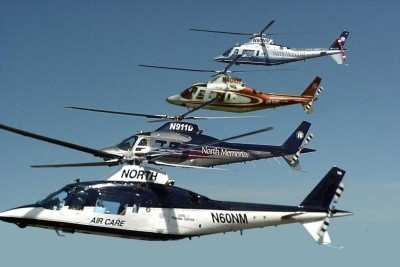Fri, Oct 02, 2020
AD 2020-20-02 Requires Inspecting Each Fire Extinguisher Bottle For A Crack
The FAA is adopting a new airworthiness directive (AD) for Leonardo S.p.a. (Leonardo) Model A109E, A109S, and AW109SP helicopters. This AD requires inspecting each fire extinguisher bottle for a crack. This AD was prompted by a report of a cracked fire extinguisher bottle. The actions of this AD are intended to address an unsafe condition on these products. This AD is effective November 3, 2020.

Supplementary Information: The FAA issued a notice of proposed rulemaking (NPRM) to amend 14 CFR part 39 by adding an AD that would apply to Leonardo Model A109E, A109S, and AW109SP helicopters with a fire extinguisher bottle part number (P/N) 27300-1 installed. The NPRM published in the Federal Register on April 23, 2020 (85 FR 22686). The NPRM proposed to require repetitively inspecting the weld beads of each fire extinguisher bottle P/N 27300-1 assembly for a crack. If there is a crack, the NPRM proposed to require replacing the fire extinguisher bottle before further flight. The NPRM also proposed to prohibit the installation of a fire extinguisher bottle P/N 27300-1 on any helicopter unless it has met the requirements of this AD. The proposed requirements were intended to detect a crack on a fire extinguisher bottle bypass outlet assembly, which could result in failure of the fire extinguishing system in the event of a fire in the engine area and subsequent loss of control of the helicopter.
The NPRM was prompted by EASA AD No. 2016-0261R1, dated February 13, 2020, issued by EASA, which is the Technical Agent for the Member States of the European Union, to correct an unsafe condition for Leonardo Model A109LUH, A109E, A109S, and AW109SP helicopters. EASA advises that a fractured bypass outlet assembly (assembly), which is a component of fire extinguishing bottle P/N 27300-1, was found during maintenance on a Model AW109SP helicopter.
EASA states that this condition, if not detected and corrected, could affect the capability of the fire extinguishing system to extinguish a fire in the engine area, resulting in damage to the helicopter and injury to any occupants. To address this unsafe condition, the EASA AD requires repetitive inspections of the assembly, and if there is a crack, replacing the fire extinguisher bottle. Due to similarity of design, EASA advises other helicopter models may be subject to the same unsafe condition.
More News
Aero Linx: Aviators Code Initiative (ACI) Innovative tools advancing aviation safety and offering a vision of excellence for aviators. The ACI materials are for use by aviation pra>[...]
Make Sure You NEVER Miss A New Story From Aero-News Network Do you ever feel like you never see posts from a certain person or page on Facebook or Instagram? Here’s how you c>[...]
From 2016 (YouTube Edition): Who You Gonna Call When You Have a Rocket Engine that Needs a Spacecraft? While at EAA AirVenture 2016, ANN CEO and Editor-In-Chief, Jim Campbell, sat >[...]
"In my opinion, if this isn't an excessive fine, I don't know what is... The odds are good that we're gonna be seeking review in the United States Supreme Court. So we gotta muster>[...]
Expedite Used by ATC when prompt compliance is required to avoid the development of an imminent situation. Expedite climb/descent normally indicates to a pilot that the approximate>[...]
 ANN's Daily Aero-Linx (04.30.25)
ANN's Daily Aero-Linx (04.30.25) ANN FAQ: Turn On Post Notifications
ANN FAQ: Turn On Post Notifications Classic Aero-TV: Agile Aeros Jeff Greason--Disruptive Aerospace Innovations
Classic Aero-TV: Agile Aeros Jeff Greason--Disruptive Aerospace Innovations Aero-News: Quote of the Day (04.30.25)
Aero-News: Quote of the Day (04.30.25) ANN's Daily Aero-Term (04.30.25): Expedite
ANN's Daily Aero-Term (04.30.25): Expedite



